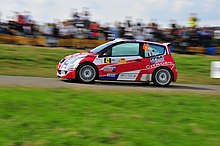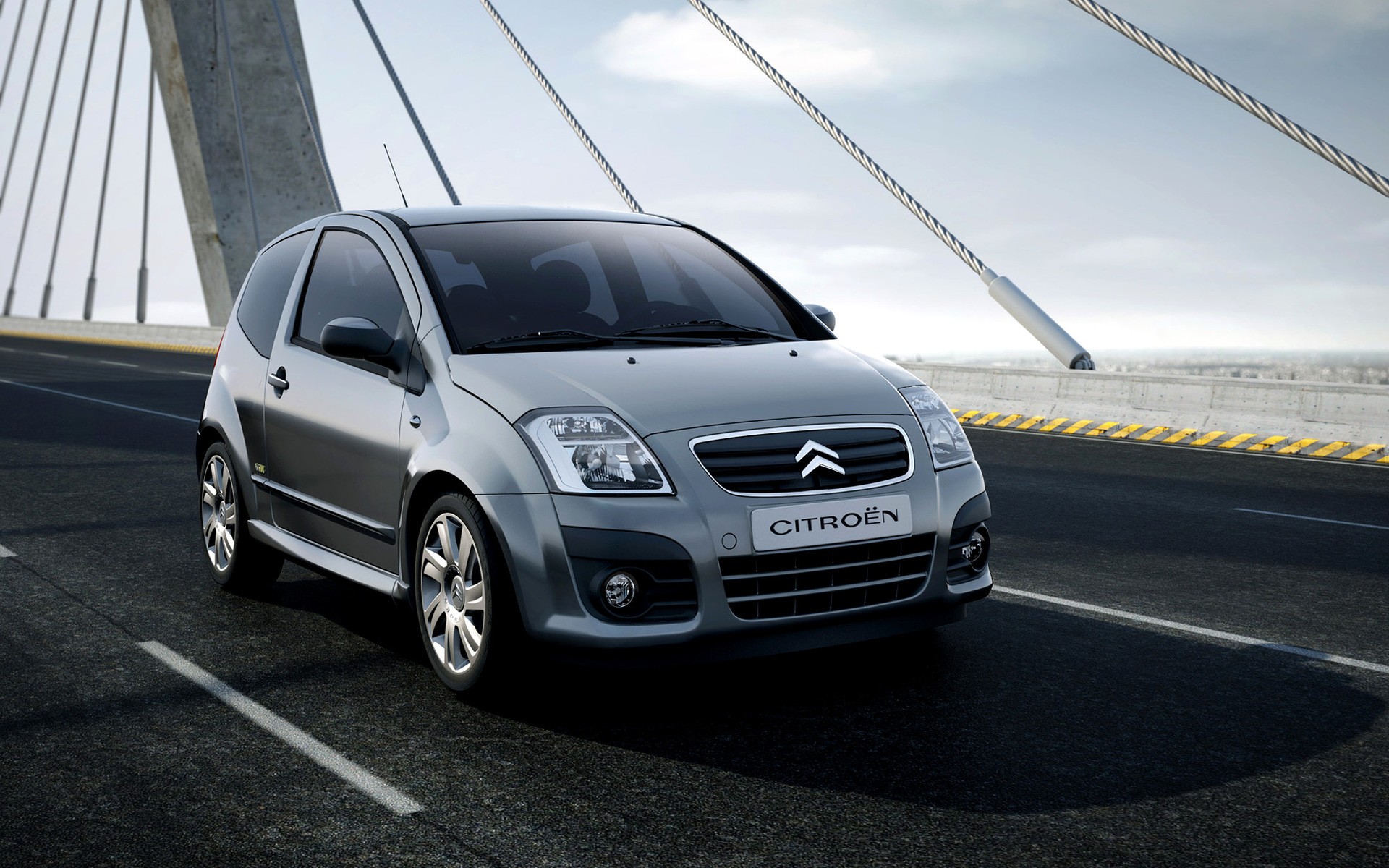| Citroën C2 | |
|---|---|
 |
|
| Overview | |
| Manufacturer | Citroën |
| Production | 2003–2009 |
| Assembly | Aulnay-sous-Bois, France |
| Designer | Donato Coco |
| Body and chassis | |
| Class | Supermini (B) |
| Body style | 3-door hatchback |
| Layout | FF layout |
| Related | Citroën C3 Peugeot 1007 Peugeot 206 |
| Powertrain | |
| Engine | 1.1 L TU1 I4 1.4 L TU3 I4 1.4 L ET3 I4 1.4 L DV4 Diesel I4 1.6 L TU5 I4 |
| Dimensions | |
| Wheelbase | 91.1 in (2,314 mm) |
| Length | 144.3 in (3,665 mm) |
| Width | 65.5 in (1,664 mm) |
| Height | 58.8 in (1,494 mm) |
| Curb weight | 2,315 lb (1,050 kg) |
| Chronology | |
| Predecessor | Citroën Saxo |
| Successor | Citroën DS3 |
The Citroën C2 is a supermini that was produced by the French manufacturer Citroën, with production starting August 2003.
It replaced the Citroën Saxo, and was built at the Aulnay plant, on the outskirts of Paris A different design of the C2, based on that of the Peugeot 206, is sold in China The Citroën C2 was discontinued in October 2009, and replaced by the Citroën DS3 in January 2010Along with the Citroën C3, the C2 successfully replaced the popular, but ageing Citroën Saxo. The two cars have relatively different designs, allowing Citroën to grab different sub markets of the supermini class. The C2 was designed by Donato Coco. The C3 was originally designed as a larger "family friendly vehicle", with its five doors, whereas the C2 was to project a "young driver" image with two doors and flatter styling. Unlike the Saxo, with 2 of 5 stars from Euro NCAP, the C2 achieved 4 out of 5 stars.
Marketing and advertising issues
Unlike its sister models, the Citroën C1 and C3, the C2 was seen as a victim of poor advertising.[citation needed] According to many in the motoring press, it was the most neglected model in the Citroën lineup in terms of promotion. In comparison, the C1 and the C3, on which the C2 is based, were both well presented in the media. Despite that, the Citroën C2 was awarded the "Best European Hatchback of 2003" in September 2003.
Versions
The LX model was the "no frills" version of the C2 and came with basic equipment, including black plastic bumpers and no fog lamps. The L model, produced from 2003 to 2005, came with black lower bumper and door handles, CD player, rear seat modulation and no fog lamps. The Design included body coloured bumpers and electric windows. The SX was the luxury spec.
It featured 'bumper colour coded paint' and air conditioning, the latter of which increases the 1.1 SX's 0–100 km/h time by 4.5 seconds to 17.2 seconds.
The Furio, VTR and VTS are the sports models which made the C2's predecessor, the Saxo, famous as an affordable, sporty looking and very fast 'pocket rocket'. The Furio has the same sports body kit as the more expensive VTR and VTS models but lacks their alloy wheels. Earlier models of the Furio had 15" Coyote alloys, but these were later replaced with wheel trims from the end of 2003 onwards.
The VTR also has a 110 bhp (82 kW; 112 PS) engine, whereas the VTS, the premium sports model, has a 125 bhp (93 kW; 127 PS) engine capable of accelerating from 0 to 60 mph (97 km/h) in 8.0 seconds, seen as sluggish by modern hot hatch standards where the fastest contemporary hot hatch achieved 5.3 seconds (Clio V6), although this is designed to be more insurance friendly. Other additions which helped the VTS model achieve a low insurance rating (in the United Kingdom) were security based including deadlocks and a Thatcham Category 1 alarm system which includes perimeter and volumetric detection as well as an engine immobiliser.
The limited edition model GT, introduced in September 2004, offered a sporty bodykit, with bright red, blue, silver and black paintwork and unique white alloy wheels. All GTs have a number certificate to show their authenticity. Only 2,250 were made, exclusive to the United Kingdom.

In 2006, there were a number of small revisions to the C2. Externally the car looks identical save minor changes to alloy wheels (on the VTR), half colour coded door mirrors, clear side indicator lenses, and white indicator rear lenses. Internal changes saw a new stereo with vehicle computer integration and some cosmetic changes to the driver displays and centre console. The previous models ran two integrated electrical systems.
The popular CAN BUS (Controller Area Network, by Bosch) and PSA's proprietary VAN BUS (Vehicle Area Network). In 2006, PSA dumped the VAN BUS system for an all CAN BUS system, giving it better functionality and compatibility with more component manufacturers. This required some of the electrical components to be replaced, explaining why the displays, radio/CD and some other electronic equipment were changed.
The VTR Sensodrive and VTS manual were the two petrol options available for the Australian C2.
Safety
Euro NCAP test results for a LHD, three-door hatchback variant on a 2003 registration:
| Test | Score | Points |
| Overall: | N/A | N/A |
| Adult occupant: | 29 | |
| Child occupant: | 29 | |
| Pedestrian: | 12 | |
| Safety assist: | N/A | N/A |
Facelift
April 2007 saw Citroën Europe announcing a facelift for its C2 model, which had received a minor update in 2006. The 2009 C2 featured a larger front bumper and restyled grille with a chrome surround. The trim specifications remain in line with the range of 2008. Levels remained unchanged.
Technology
The Citroën C2 brings with it two key new technologies, the Stop & Start environmental system, and the SensoDrive five speed semi-automatic transmission.
- The Stop & Start is a hybrid system, with the internal combustion engine being supplemented by a small electric motor. The "Stop & Start" system automatically disengages the engine when you bring the vehicle to a complete stop, with pressure being applied to the brake pedal.
The engine quickly restarts when pressure on the brake pedal is relieved. The technology has been developed by Valeo and results in lower urban fuel consumption. The system, however, requires pressure on the brake pedal when stationary for the system to work, holding the vehicle on the handbrake (parking brake) alone will not be sufficient for the system to operate. The Stop & Start system is mounted to the SensoDrive gearbox.
A Stop & Start system was previously seen in the 1980s, with the Volkswagen Polo "Formel E" and the Volkswagen Golf MKIII "Ecomatic", although this was different in operation; in the Volkswagen system the engine stopped automatically when placed in neutral. Selecting a gear by moving the stick to the left (for first or reverse) activated the starter motor.
- The SensoDrive five speed semi-automatic transmission is an electronically controlled manual gearbox, with the clutch and gear-change functions electronically managed. As a result, the vehicle has no clutch pedal and the gear lever, which remains present, has no mechanical link with the gearbox. The SensoDrive gearbox is managed by a control unit, which controls two actuators.
One actuator changes gears while the other, which is equipped with a facing wear compensation system, opens and closes the clutch. The gearbox control unit also dialogues with the engine control unit. The SensoDrive gearbox has two shifting options of either the fully automated mode, or the paddle-shifted/gear-shifted manual mode.
Engines available
- 1.1 L TU1 (1124 cc) I4, 60 PS (59 hp/44 kW)
- 1.4 L TU3 (1360 cc) I4, 75 PS (73 hp/55 kW)
- 1.4 L ET3 SensoDrive Stop & Start (1360 cc) I4, 90 PS (88 hp/66 kW)
- 1.4 L DV4 HDi Diesel (1398 cc) I4, 68 PS (67 hp/50 kW) and 111 lb·ft (150 N·m)
- 1.6 L TU5 SensoDrive VTR (1587 cc) I4, 110 PS (108 hp/80 kW)
- 1.6 L TU5 VTS (1587cc) I4, 125 PS (123 hp/91 kW)
- 1.6 L DV6 HDi Diesel (1560cc) I4, 110 PS (109 hp/80 kW) and 198 lb·ft (269 N·m)
Trim levels

United Kingdom trim levels
2003–2008
- L
- Airplay
- LX
- Design
- Cool
- SX
- Stop & Start
- Furio
- VTR
- VTS
- GT (Limited Edition 2004)
- Loeb (Limited Edition 2007)
- Code (Limited Edition 2007)
2008–2009
- Vibe 1.1i and 1.4HDi.
- Rhythm 1.1i, 1.4i and 1.4HDi.
- Cachet 1.1i and 1.4i.
- Stop & Start 1.4i 16v 90 bhp (67 kW; 91 PS) SensoDrive.
- VTR 1.4i, 1.6i 16v 110 bhp (82 kW; 112 PS) SensoDrive and 1.4HDi. All Now With Air Con.
- VTS 1.6i 16v 125 bhp (93 kW; 127 PS) and 1.6HDi 16v 110 bhp (82 kW; 112 PS).
- Code 1.6i 16v 125 bhp (93 kW; 127 PS).
Chinese version

From October 2006, the Peugeot 206 has been sold by PSA, for the Chinese market only as the Citroën C2. With a modified front and rear body, this is similar to the way the Citroën LN was derived from the Peugeot 104. The car has no common features with the model sold on other markets, due to the positioning of the model in the Citroën China line up.
It is produced in China at the Wuhan Dongfeng Peugeot-Citroën Automobile site. It has a length of 388 cm (153 in), width of 168 cm (66 in), height of 144 cm (57 in), with a wheelbase of 244 cm (96 in), and is powered by one of the two engine options: a 1.4 L (76 hp or 57 kW) and a 1.6 L (106 hp or 79 kW). Weight ranges from 1,040 kg (2,290 lb) to 1,100 kg (2,400 lb).
C2 in motorsport

After the success of Citroën's Xsara in the World Rally Championship (WRC), Citroën expanded their interests to achieve success not only in the WRC but in the support championship, the Junior World Rally Championship (JWRC) in 2004. The earlier Citroën Saxo Super 1600 JWRC car was highly successful. The car won the JWRC title with Sébastien Loeb in 2001, and brought him to the attention of Citroën Total World Rally Team, and again with Daniel Solà in 2002.
With the new C2 replacing the aging Saxo, Citroën concentrated upon making their new car a winner. Using a heavily modified C2 to create the Citroën C2 S1600, the works team and Dani Sordo succeeded in winning the championship in 2005. The C2 S1600 has continued to compete in the championship with privateer teams, and remains successful despite newer machinery from Suzuki, Renault and Fiat works teams. In the 2008 season, Sébastien Ogier brought the Citroën C2 its second junior title, and in 2009, the C2 was again the title-winning car, with Martin Prokop taking the championship.
Sales and production
| Year | Worldwide Production | Worldwide sales | Notes |
| 2009 | 49,100 | 52,400 | |
| 2010 | 8,200 | 9,300 | |
| 2011 | 10,403 | 10,468 | Total production reaches 676,004 units. |
| 2010 | 14,800 | 14,600 | Total production reaches 690,800 units. |









